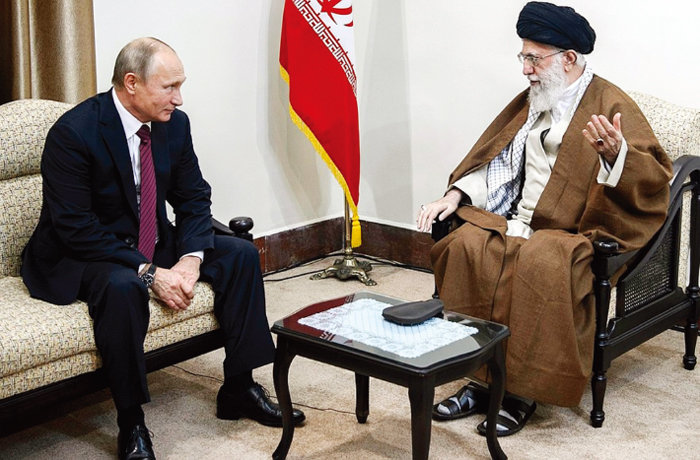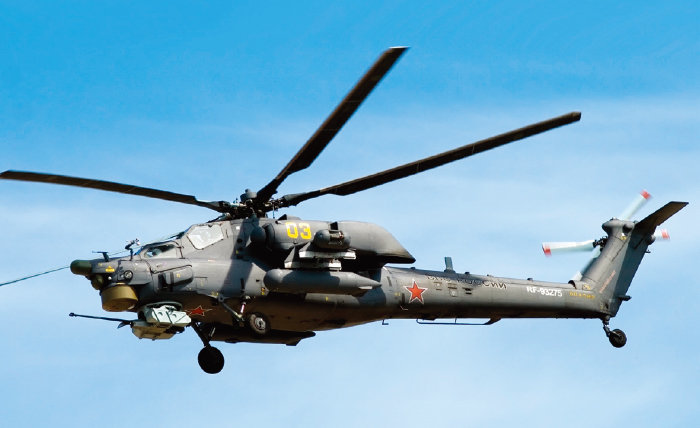North Korea gave 1,000 containers worth of artillery shells, may receive support for fighter jets or parts
When North Korean Chairman Kim Jong-un visited Russia, one of the weapons he most looked at was the Su-35 fighter jet. Chairman Kim watched the final assembly process of the multipurpose fighter Su-35, stealth fighter Su-57, and new passenger aircraft Su Superjet (SJ)-100 at the Yuri Gagarin Aircraft Factory in Komsomolsk-on-Amur, Khabarovsk Region, Russia, on September 15. . In particular, after observing the test flight of the Su-35 fighter jet, Chairman Kim met with the pilots, encouraged them, and even took a commemorative photo of him with this fighter jet in the background.
 Russian President Vladimir Putin (left) is talking with Iran’s Supreme Leader Ayatollah Ali Hossein Khamenei while visiting Tehran, Iran, in July last year. Kremlin
Russian President Vladimir Putin (left) is talking with Iran’s Supreme Leader Ayatollah Ali Hossein Khamenei while visiting Tehran, Iran, in July last year. KremlinThe reason Chairman Kim visited this factory was because he expected to introduce fighter jets from Russia to strengthen air power. North Korea operates mostly fighter jets manufactured in the 1950s and 1960s, including the MiG-15 and MiG-17. As for the latest fighter aircraft, it only has a few 4th generation MiG-29s. Chairman Kim must have been impressed when he saw the test flight of the Su-35.
The Su-35 is Russia’s main fighter aircraft. It was made by completely replacing the radar, avionics equipment, and engine of the Su-27, the old main aircraft. The Su-35 is classified as a 4.5 generation fighter, between a 4th generation fighter and a 5th generation stealth fighter, and has been introduced into the Russian military since 2014. The maximum speed is Mach 2.35 (about 2800 km/h), the range is 3600 km, and the combat radius is 1600 km, making it capable of high-speed and high-altitude flight. It is equipped with a 30mm cannon and 12 air-to-air and air-to-ground missiles, and is also equipped with AS-17 supersonic anti-ship missiles.
Iran, which has little difference in air power from North Korea, is purchasing a large number of Su-35 fighter jets, Mi-28 attack helicopters, and Yak-130 advanced trainer aircraft from Russia. The Mi-28 is the main aircraft operated together with the Kamov (Ka)-52 in the Russian military and has excellent night operation capabilities, so much so that it is called ‘Nochnoy Ahotnik’ (night hunter) in Russian. The Yak-130 is a next-generation advanced trainer aircraft equipped with twin engines developed by Russia to replace the L-39 Albatross trainer aircraft.
 The Russian attack helicopter Mi-28, known as the ‘night hunter’ for its excellent night operation capabilities. Russian Ministry of Defense
The Russian attack helicopter Mi-28, known as the ‘night hunter’ for its excellent night operation capabilities. Russian Ministry of DefenseIran’s Ministry of Defense announced that its pilots are undergoing flight training after the Yak-130 advanced trainer aircraft was delivered in September. Iran’s Ministry of Defense emphasized that the country has the strongest military helicopter fleet in the region and that its capabilities have improved as it carries out several projects.
What is noteworthy is that the arms deal between Iran and Russia is a ‘compensation’ for Iran providing suicide drones and short-range ballistic missiles to Russia. Iran is believed to have supplied Russia with at least 1,000 suicide drones called Shahed-136. Shahed-136 has a length of 3.5 m, a wingspan of 2.5 m, a take-off weight of 200 kg, and a motorcycle engine, making it inexpensive. The fuselage is light and has a large fuel capacity, so it can fly up to 2,000 km.
With technology provided by Iran, Russia is domestically producing Shahed-136 under the name ‘Geran-2’ and is building two manufacturing plants. It is believed that Russia is also receiving supply of ‘Fate-110’ and ‘Zolfagar’ short-range ballistic missiles with a range of 300 to 700 km from Iran.
Iran is a military powerhouse, but its air force is evaluated to be nowhere near that level. This is because it is far inferior to its rivals in the Middle East, Saudi Arabia and the United Arab Emirates (UAE), as well as its enemy Israel. Iran has been making every effort to strengthen its air force, but has repeatedly failed due to strong sanctions from the West, including the United States. The Iranian Air Force used fighter jets purchased from the United States before the Islamic Revolution in 1979, and its main aircraft was the F-14. Iran imported MiG-29 fighter jets from Russia in the 1990s, but was no longer able to import them due to strong sanctions from the West, including the United States. In 2018, Iran introduced its own fighter jet called ‘Khousar’, which Western military experts believe was a copy of the F-5 fighter jet developed by the United States in the 1960s and supplied to its allies.
It is clear that Iran’s air force will be significantly strengthened if it acquires Su-35 fighter jets from Russia. Western military experts pointed out that if Iran introduces Russian-made fighter jets, helicopters, and trainers, it will provide an opportunity to improve its air force, which is inferior to that of Saudi Arabia and Israel. It is not known how many Su-35 fighter jets Iran will acquire from Russia, but it is estimated that it will be around 24 that Russia had agreed to export to Egypt. Egypt ordered 24 Su-35s from Russia last year, but canceled it.
National Interest, an American security media outlet, highly praised the Su-35 fighter jet, saying, “The Su-35 fighter jet has unrivaled mobility and an excellent bomb load capacity.” Of course, the Su-35 does not have a stealth function, so its performance is somewhat inferior to that of the F-35, America’s 5th generation multipurpose stealth fighter. Nevertheless, China has introduced 24 Su-35s from Russia and is operating them for patrols in the South China Sea and Taiwan. This is because the Su-35 also has multipurpose functions such as air combat and bombing.
The Iranian military is expected to deploy some of the Su-35s it is acquiring from Russia at the Air Force’s 8th Tactical Base in Isfahan. Isfahan has a uranium reprocessing facility that turns uranium ore concentrate called uranium salt into uranium hexafluoride gas, and nearby Natanz has a uranium enrichment facility that can produce highly enriched uranium for nuclear bomb production.
Iran is actively developing hypersonic missiles with support from Russia. Russia is significantly ahead of the United States and China in the development of hypersonic missiles, and is already using the hypersonic missile ‘Kinzal’ in the war with Ukraine. The maximum speed of the Kinzal missile is Mach 12 (about 14,600 km/h) and the range is 2,000 km. Iran announced that it had successfully test-launched its self-developed hypersonic missile ‘Fatakh-1’ on November 21 and released a video of the missile hitting its target.
Fatakh-1 flies at a speed of Mach 13 to Mach 15 and can hit targets at a distance of 1,400 km. It uses solid fuel, can change orbit even outside the atmosphere, and has a stealth function. Amir Ali Hajizadeh, commander of the Space Force of Iran’s Revolutionary Guard, said, “This missile cannot be intercepted by any existing air defense system,” and claimed, “There are only four countries in the world, including Iran, that have such technology.” Iran plans to increase the range of this missile to 2,000 km. Iran previously announced on June 6 that it had developed a hypersonic missile. At the time, Iran did not disclose the footage of the hypersonic missile launch.
Western military experts believe that Russia is likely to have provided Iran with the technology needed to develop hypersonic missiles and satellites. John Kirby, strategic communications coordinator for the White House’s National Security Council (NSC), pointed out that “Russia supports Iran’s missile development and satellite intelligence collection capabilities,” and added, “Military cooperation between Russia and Iran is noticeably increasing.” did.
The blatant military cooperation between Iran and Russia is expected to pose a threat to Western countries, including the United States. Foreign Policy, an American diplomatic magazine, analyzed that “the dramatic cooperative relationship between Iran and Russia is rapidly emerging as a new threat to the West.”
Russia and Iran are expected to strengthen cooperation in various fields, including military cooperation and the economy. In fact, the two countries recently signed a contract for the construction of a railway network as part of the North-South International Transportation Corridor. This project, worth 1.6 billion dollars (approximately 2.1 trillion won), will connect a 162km section by rail from Rasht, a city on the Caspian Sea coast of Iran, to Astara, a border city in Azerbaijan. Russia expects that once this section is completed, it will become an important trade route by connecting Russia’s Baltic Sea ports with the Indian Ocean in southern Iran. It is clear that the all-round cooperation between the two countries will serve as a new variable not only in the Middle East region but also in the international order.
Western military experts are further paying attention to whether Russia will provide fighter jets to North Korea, which wants to strengthen its air force. Iran acquired the Su-35 in return for supplying drones to Russia. Since North Korea also supplied large quantities of various weapons, including artillery shells, to Russia, it can receive Su-35 fighter jets in return. The U.S. White House disclosed the fact that North Korea provided 1,000 containers worth of artillery shells to Russia, along with satellite photos, and criticized the illegal military cooperation between the two countries. Western military experts warned that “North Korea is selecting people to receive training in flight control and parts maintenance in Russia,” and that “Russia may provide fighter jets or related parts to North Korea.”
In 1988, North Korea, in collaboration with the former Soviet Union, built a MiG-29 assembly and production plant in Guseong, North Pyongan Province. A fighter jet was made by taking parts and assembling them. The first two units were built in April 1993 to commemorate President Kim Il-sung’s birthday, and a total of 20 units were assembled and produced thereafter. Several of them crashed, and about 10 are currently in operation. However, as the plant was shut down due to the collapse of the Soviet Union, it was having difficulty procuring MiG-29 parts, and the ability to return parts was reaching its limit. For this reason, Russia may supply MiG-29 parts to North Korea.
[이 기사는
주간동아 1418호
에 실렸습니다]
Jang-Hoon Lee, international affairs analyst [email protected]
Source: Donga
Mark Jones is a world traveler and journalist for News Rebeat. With a curious mind and a love of adventure, Mark brings a unique perspective to the latest global events and provides in-depth and thought-provoking coverage of the world at large.